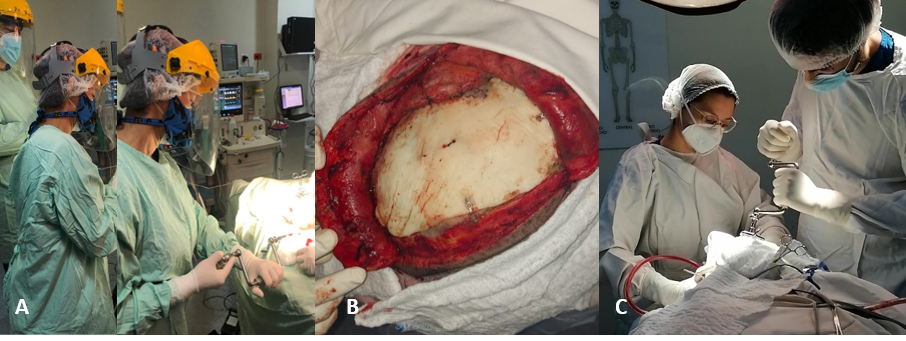The Brain Trauma Foundation (BTF) Guidelines for the Management of Traumatic Brain Injury have been considered the gold standard document for evidence-based interventions in TBI care worldwide (1). Since their introduction in the late 90s, other international guidelines have been published with similar structure or just as an adaptation or adoption process (2–7).
Most of these guidelines have been developed in high income countries (HIC’s), were advanced technology for neuromonitoring is available. Unfortunately, some of these devices are not worldwide available and limits the application of some recommendations, including a barrier for defining thresholds for urgent decision making (8). This current situation creates a critical gap in knowledge transferability when it is required to adapt or develop local protocols, especially in low- and middle-income countries (LMIC´s) (Figure 1).

Guidelines and Protocols from HIC’s and LMIC’s
We present a summary of the main international HIC’s and LMIC’s guidelines in Table 1, including the link for their complete access (1-7) (9-11). Then, in Table 2 we describe Guidelines, Consensus and Protocols that has been developed with the aim of address the gaps in knowledge transferability for the management of TBI cases were not all the resources are available (12-15), including the recent BOOTStraP Consensus, that define stratified protocols for applying it according to the available resources and training level for near to 10 different scenarios for Prehospital (EMS), Emergency Room (ER), Intensive Care Unit (ICU) or Operation Room (OR) (Figure 2) (15).

Table 1. Main international guidelines from HIC’s and LMIC’s.
Table 2. International guidelines and protocols for specific situations in TBI patients
Traumatic brain injury management is a critical intervention for tackling one of the main diseases associated with the bigger burden of death and disability worldwide. Several guidelines, consensus and protocols have been proposed, mostly developed in HIC’s. Knowledge transferability barriers have been identified when applying international guidelines in LMIC´s. Recently some specific guidelines, consensus, and protocols, oriented for decision making in areas were not all the resources exists have been developed. The stratification of care according to the level of resources and training is opening a new era in consensus and protocol development for a global application.
References
- Carney N, Totten AM, O’Reilly C, Ullman JS, Hawryluk GW, Bell MJ, Bratton SL, Chesnut R, Harris OA, Kissoon N, Rubiano AM, Shutter L, Tasker RC, Vavilala MS, Wilberger J, Wright DW, Ghajar J. Guidelines for the Management of Severe Traumatic Brain Injury, Fourth Edition. Neurosurgery. 2017 Jan 1;80(1):6-15.
- Yamada K, Yoshimine T; Guidelines Committee on the Management of Severe Head Injury, Japan Society of Neurotraumatology. Guidelines for the Management of Severe Head Injury, 2nd Edition guidelines from the Guidelines Committee on the Management of Severe Head Injury, the Japan Society of Neurotraumatology. Neurol Med Chir (Tokyo). 2012;52(1):1-30.
- Potapov AA, Krylov VV, Gavrilov AG, Kravchuk AD, Likhterman LB, Petrikov SS, Talypov AE, Zakharova NE, Oshorov AV, Solodov AA. Guidelines for the management of severe head injury. Part 1. Neurotrauma system and neuroimaging. Zh Vopr Neirokhir Im N N Burdenko. 2015;79(6):100-106
- Potapov AA, Krylov VV, Gavrilov AG, Kravchuk AD, Likhterman LB, Petrikov SS, Talypov AE, Zakharova NE, Oshorov AV, Sychev AA, Alexandrova EV, Solodov AA. Guidelines for the diagnosis and treatment of severe traumatic brain injury. Part 2. Intensive care and neuromonitoring. Zh Vopr Neirokhir Im N N Burdenko. 2016;80(1):98-106.
- Potapov AA, Krylov VV, Gavrilov AG, Kravchuk AD, Likhterman LB, Petrikov SS, Talypov AE, Zakharova NE, Solodov AA. Guidelines for the management of severe traumatic brain injury. Part 3. Surgical management of severe traumatic brain injury (Options). Zh Vopr Neirokhir Im N N Burdenko. 2016;80(2):93-101
- Liao KH, Chang CK, Chang HC, Chang KC, Chen CF, Chen TY, Chou CW, Chung WY, Chiang YH, Hong KS, Hsiao SH, Hsu YH, Huang HL, Huang SC, Hung CC, Kung SS, Kuo KN, Li KH, Lin JW, Lin TG, Lin CM, Su CF, Tsai MT, Tsai SH, Wang YC, Yang TY, Yu KF, Chiu WT; Brain Trauma Foundation. Clinical practice guidelines in severe traumatic brain injury in Taiwan. Surg Neurol. 2009 Dec;72 Suppl 2:S66-73; discussion S73-4.
- Maas AI, Dearden M, Teasdale GM, Braakman R, Cohadon F, Iannotti F, Karimi A, Lapierre F, Murray G, Ohman J, Persson L, Servadei F, Stocchetti N, Unterberg A. EBIC-guidelines for management of severe head injury in adults. European Brain Injury Consortium. Acta Neurochir (Wien). 1997;139(4):286-94
- Kolias AG, Rubiano AM, Figaji A, Servadei F, Hutchinson PJ. Traumatic brain injury: global collaboration for a global challenge. Lancet Neurol. 2019 Feb;18(2):136-137.
- Ministry of Health and Social Protection, Colciencias, MEDITECH Foundation. Clinical Practice Guideline for the diagnosis and treatment of adult patients with severe Traumatic Brain Injury. GSSSH – 2014. Guide No. 30 CPG-TBI. Bogotá, 2014.
- Guías Clínicas, Traumatismo Encéfalo Craneano Moderado o Grave. MINSAL Chile, 2013
- AAPI / AASAN TRAUMATIC BRAIN INJUR Y Multi Organizational Consensus Recommendations for India, 2014.
- Newcombe R, Merry G. The management of acute neurotrauma in rural and remote locations: A set of guidelines for the care of head and spinal injuries. J Clin Neurosci. 1999 Jan;6(1):85-93.
- Picetti E, Rossi S, Abu-Zidan FM, Ansaloni L, Armonda R, Baiocchi GL, Bala M, Balogh ZJ, Berardino M, Biffl WL, Bouzat P, Buki A, Ceresoli M, Chesnut RM, Chiara O, Citerio G, Coccolini F, Coimbra R, Di Saverio S, Fraga GP, Gupta D, Helbok R, Hutchinson PJ, Kirkpatrick AW, Kinoshita T, Kluger Y, Leppaniemi A, Maas AIR, Maier RV, Minardi F, Moore EE, Myburgh JA, Okonkwo DO, Otomo Y, Rizoli S, Rubiano AM, Sahuquillo J, Sartelli M, Scalea TM, Servadei F, Stahel PF, Stocchetti N, Taccone FS, Tonetti T, Velmahos G, Weber D, Catena F. WSES consensus conference guidelines: monitoring and management of severe adult traumatic brain injury patients with polytrauma in the first 24 hours. World J Emerg Surg. 2019 Nov 29;14:53
- Chesnut RM, Temkin N, Videtta W, Petroni G, Lujan S, Pridgeon J, Dikmen S, Chaddock K, Barber J, Machamer J, Guadagnoli N, Hendrickson P, Aguilera S, Alanis V, Bello Quezada ME, Bautista Coronel E, Bustamante LA, Cacciatori AC, Carricondo CJ, Carvajal F, Davila R, Dominguez M, Figueroa Melgarejo JA, Fillipi MM, Godoy DA, Gomez DC, Lacerda Gallardo AJ, Guerra Garcia JA, Zerain GF, Lavadenz Cuientas LA, Lequipe C, Grajales Yuca GV, Jibaja Vega M, Kessler ME, López Delgado HJ, Sandi Lora F, Mazzola AM, Maldonado RM, Mezquia de Pedro N, Martínez Zubieta JR, Mijangos Méndez JC, Mora J, Ochoa Parra JM, Pahnke PB, Paranhos J, Piñero GR, Rivadeneira Pilacuán FA, Mendez Rivera MN, Romero Figueroa RL, Rubiano AM, Saraguro Orozco AM, Silesky Jiménez JI, Silva Naranjo L, Soler Morejon C, Urbina Z. Consensus-Based Management Protocol (CREVICE Protocol) for the Treatment of Severe Traumatic Brain Injury Based on Imaging and Clinical Examination for Use When Intracranial Pressure Monitoring Is Not Employed. J Neurotrauma. 2020 Jun 1;37(11):1291-1299.
- Rubiano AM, Vera DS, Montenegro JH, Carney N, Clavijo A, Carreño JN, Gutierrez O, Mejia J, Ciro JD, Barrios ND, Soto AR, Tejada PA, Zerpa MC, Gomez A, Navarrete N, Echeverry O, Umaña M, Restrepo CM, Castillo JL, Sanabria OA, Bravo MP, Gomez CM, Godoy DA, Orjuela GD, Arias AA, Echeverri RA, Paranos J. Recommendations of the Colombian Consensus Committee for the Management of Traumatic Brain Injury in Prehospital, Emergency Department, Surgery, and Intensive Care (Beyond One Option for Treatment of Traumatic Brain Injury: A Stratified Protocol [BOOTStraP]). J Neurosci Rural Pract. 2020 Jan;11(1):7-22.








